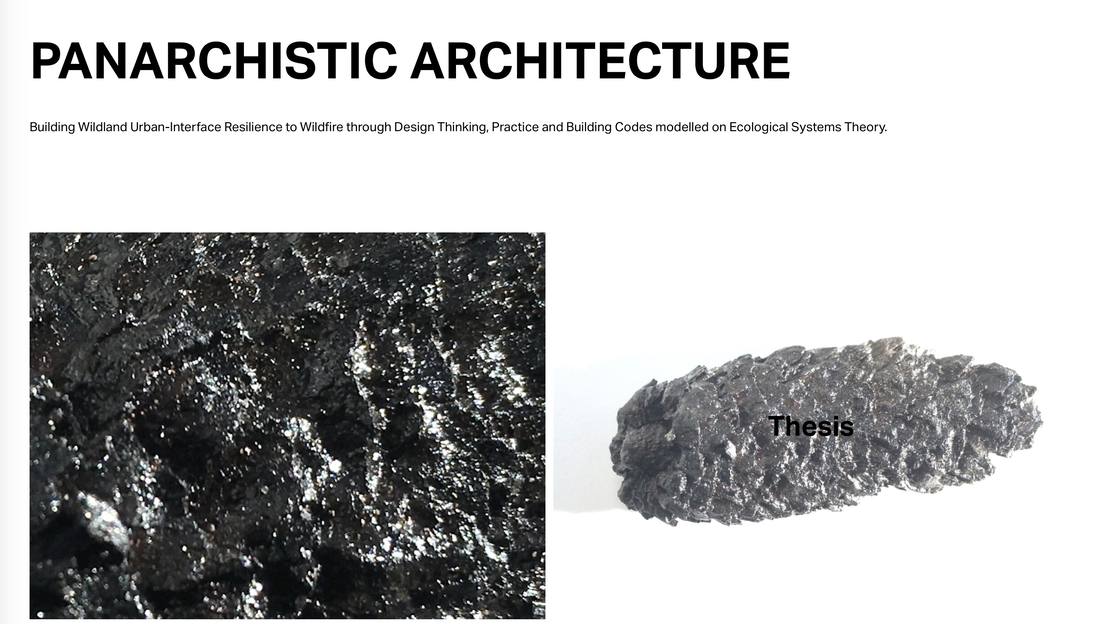|
The product of an extensive transdisciplinary programme researching the potential for building resilience to wildfires through the mimicry of the biochemistries, behaviours, relationships and systems of fire-adapted species, and the assemblages the form, Panarchistic Architecture posits a radical new architectural and urban design paradigm for the wildland-urban-interface. The thesis, ongoing publishing works, including a podcast and an interview series, together with updates on research collaborations, lectures, and more, are available open access at www.panarchiccodex.com.
Extract: "Situated in a yet to be “established” field (Smith et al, 2016), this site and the works it hosts explore one of the most complex and contentious challenges or our time - the problem of living with wildfire on an “inherently” flammable planet” (Bowman et al, 2011). Residing at the apex of Earth systems, wildfire has been integral to the development of much terrestrial plant and animal life on Earth. But, its role in the evolution of our own lineage - Primates, and latterly Humans - is arguably the most compelling, curious, and currently, crucial of all. Multiple factors signalling the advent of a new “fire age” (Pyne, 2016), the paradigm presented here takes the task of living with wildfire back to the design drawing board, asking not how we, humans, would solve the problem, but how fire-adapted flora already have." Read more here.
0 Comments
Adapting to these fast shape-shifting times, earlier this week I had the pleasure to virtually join peers Prof. Claudia Pasquero, Dr. Marco Poletto, and Maria Kuptsova at the Synthetic Landscape Lab at the Faculty of Architecture at University of Innsbruck to critique the final diploma presentations of students Lisa Brunner and Stefan Fuchs. Brunner presented a concept for a peri-urban algae lab which, integrating scientific research with public communications, posits the possibility of buildings that 'breath', as inflatable algae-filled transparent exterior panels expand and contract with the changing seasons, thus passively control the buildings' internal climates. Whereas Brunner's presentation explored the idea of apiary being scaled to architectural proportions, wherein the architect bio-morphically configures an architectural ruin to house several hives, a honey-extractor, and a shop [one of Brunner's developmental models is pictured above]. Their presentations shared via a Zoom meeting, watched by over 60 of their fellow students, and others with an interest in biodesign and synthetic ecologies, both did well to transform works that were originally intended for an exhibition and in-person critique, to an online audience. Well done to both, and to their professor, Claudia, and their tutors, and to the lab for putting such dynamic diploma course together.
|
AuthorMelissa Sterry, PhD, chartered design scientist, systems theorist, biofuturist, and serial founder inc. Bionic City® Bionic CityAsking the question "how would nature design a city" since 2010.
Archives
October 2023
Categories#bionics
#biotech #biodesign #bioscience #biomimetics #biotechnology #bioengineering #bioinnovation #bioaesthetics #biorevolution #bioenterprise #biosystems #biocreative #biofuturism #biofutures #biocentric #biofacture #biotecture #biovation #biofiction #biourban #biocities #biolab #bioart #STEM
#STEAM #STEAMED #STEMcomms #STEAMcomms #STEAMEDcomms © Bioratorium Limited & Melissa Sterry
2021 All Rights Reserved |



 RSS Feed
RSS Feed

